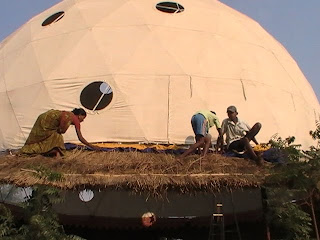 What I have heard since arriving in India is "women can't do this, can't do that." That is pretty hard to take since I was instructed about Feminism at 21 years old by my mother-in-law, Gerry Monosoff, who was very active in breaking new ground for women in the 60's. American women would not be where they are today if it was not for women like Gerry standing up to those men who were telling women who, what and how they could be.
What I have heard since arriving in India is "women can't do this, can't do that." That is pretty hard to take since I was instructed about Feminism at 21 years old by my mother-in-law, Gerry Monosoff, who was very active in breaking new ground for women in the 60's. American women would not be where they are today if it was not for women like Gerry standing up to those men who were telling women who, what and how they could be.Here is Cuckoo (Vanita II) balancing grass that she has cut on the river bank as she climbs up our spiral staircase.
So, I do get all riled up when I hear things like "women can't do this, they can't do that." Like today, the men needed some help putting up some bamboo strips to make a shade arbor. "Women can't do that, they aren't strong enough."
"Excuse me. Weren't those women who were digging up those heavy rocks and moving them on their heads? And weren't those women digging up cement, digging up a leach field, digging up a compost pile? Moving rocks the size of a small child. Excuse me! Those women are strong and able and willing. So don't tell me they can't hold up a little piece of bamboo for a few minutes in the air while you men twist a little piece of wire around the bamboo."
 I let those men know I could not agree with their decision not to let the women help them. I rattled off my upset even though I knew they would not understand a word I said. But I think they got my drift. Then, one of my colleagues told me the real reason why they didn't want women helping them. They didn't know how to talk to women. Men can't talk to women. Men have their own talk and women have theirs. Oh, Gerry, we have a long ways to go here in India.
I let those men know I could not agree with their decision not to let the women help them. I rattled off my upset even though I knew they would not understand a word I said. But I think they got my drift. Then, one of my colleagues told me the real reason why they didn't want women helping them. They didn't know how to talk to women. Men can't talk to women. Men have their own talk and women have theirs. Oh, Gerry, we have a long ways to go here in India.Women Painting, OMG:
I feel I broke new ground today, when Vanita, my cook, said she wants to learn to paint. Oh my Goodness. "Women don't paint." But she has seen me mixing colors and painting walls, trim, whatever. And enjoying getting paint all over me in the process. And now she wants to paint. She was a little timid at first, but I said it was like putting on cake frosting. This is the same woman I am teaching to bake. Remember my Marathi is very limited, so I have to think of ways to explain things in words that I know. Anyway, she got the picture. "Ami soy-pak color." "We are cooking up paint." We both laughed and I loved seeing her try something new and breaking through those limited ideas of what she as a woman can and can't do. She got so inspired, she painted our kitchen. At first she had me mix the colors, but I had her make suggestions so that she could see how one figures out how to match colors. Before I knew it she took that paint and painted the entire kitchen with new paint. We were cooking paint today.




